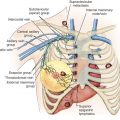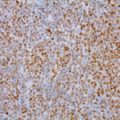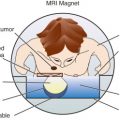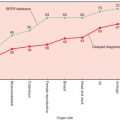Abstract
There are now interventions to reduce a woman’s chance of being diagnosed with breast cancer as well as strategies for the screening of increased or high-risk women. It is essential that clinicians in primary care settings recognize women at increased or high risk of breast cancer due to personal risk factors, medical conditions, or family history, so that appropriate screening activities can be encouraged, appropriate risk-reduction interventions offered, and/or referral made to specialists for cancer risk assessment and counseling. The intent of this chapter is to bring the components of breast cancer risk assessment, risk reduction, and screening, the specifics of which are discussed in depth in other chapters, into a clinical perspective. A practical approach to identifying breast cancer risk, the components of the risk assessment process, and recommendations for the clinical management of women at increased and high risk for breast cancer are reviewed.
Keywords
risk assessment, risk reduction, screening, increased risk, high risk
For a number of years, there has been a steady decline in the number of women dying of breast cancer. This has been attributed to a combination of early detection from mammographic screening and improved treatment strategies. The decline in the use of hormone replacement therapy (HRT), due in large part to published data from the Women’s Health Initiative showing an association between HRT and breast cancer, is a probable contributing factor. A possible contributing factor is the use of raloxifene since 1999 for osteoporosis prevention and treatment because it has also been shown to reduce the incidence of breast cancer.
There are now interventions to reduce a woman’s chance of being diagnosed with breast cancer as well as strategies for the screening of increased or high-risk women. It is essential that clinicians in primary care settings recognize women at increased or high risk of breast cancer due to personal risk factors, medical conditions, or family history, so that appropriate screening activities can be encouraged, appropriate risk reduction interventions offered, and/or referral made to specialists for cancer risk assessment and counseling.
The intent of this chapter is to bring the components of breast cancer risk assessment, risk reduction, and screening, the specifics of which are discussed in depth in other chapters, into a clinical perspective. A practical approach to identifying breast cancer risk, the components of the risk assessment process, and recommendations for the clinical management of women at increased and high risk for breast cancer are reviewed.
Breast Cancer Risk Assessment
Breast cancer risk assessment involves identifying a woman’s breast cancer risk factors and determining her probability of developing breast cancer. It serves as a basis for recommendations on appropriate preventive interventions and screening strategies based on her level of risk.
Qualitative Breast Cancer Risk Assessment
Numerous risk factors for the development of breast cancer have been identified ( Box 80.1 ). Being female and becoming older are the most common risk factors. However, these risks apply to all women and are not clinically useful because they provide no ability to discriminate the breast cancer risk of one woman compared with another. The lifetime risk of breast cancer in the United States is 1 in 8 (about 12%). This commonly quoted lifetime risk estimates populational risk, not individual cancer risk.
Female gender
Age
Race/ethnicity
Family history
Sporadic
Familial
Hereditary (e.g., BRCA1, BRCA2, Li-Fraumeni and Cowden syndromes)
Ashkenazi Jewish heritage
Reproductive/hormonal
Early menarche (<12 years)
Late menopause (>55 years)
Late age of first live birth (>30 years)
Nulliparity
Parity
Never breastfed a child
Recent use of hormonal contraception
Recent and long-term use of hormone replacement therapy
Medical history
Personal history of breast cancer
Personal history of endometrial, ovarian, or colon cancer
Atypical hyperplasia
Lobular carcinoma in situ
Therapeutic thoracic radiation between 10 and 30 years of age
Increased breast density
Increased bone density (postmenopausal)
Lifestyle
Adult weight gain
Obesity (postmenopausal)
Physical inactivity
Alcohol consumption
High socioeconomic status
Somewhat more helpful are age-specific risks because this focuses a woman’s attention on risks of women in her age range ( Table 80.1 ). However, these categories include women at minimal risk and those at very high risk. The actual risk to any individual woman may be very different. Age-specific incidence rates increase dramatically beginning at 40 years of age.
| Current Age | Probability of Developing Breast Cancer in the Next 10 Years |
|---|---|
| 20 | 0.1% (1 in 1674) |
| 30 | 0.4% (1 in 225) |
| 40 | 1.4% (1 in 69) |
| 50 | 2.3% (1 in 44) |
| 60 | 3.5% (1 in 29) |
| 70 | 3.9% (1 in 26) |
| Lifetime risk | 12.3% (1 in 8) |
a Among women free of cancer at beginning of age interval. On the basis of cases diagnosed between 2010 and 2012. Percentages and “1 in” numbers may not be numerically equivalent due to rounding.
Quantitative Breast Cancer Risk Assessment
Mathematical models have been developed to quantitate a woman’s risk of developing breast cancer. The National Cancer Institute (NCI) Breast Cancer Risk Assessment Tool (BCRAT) assesses breast cancer risk using nongenetic factors. The hereditary/familial models (e.g., Claus, Tyrer-Cuzick, and BRCAPRO models) assess genetic and familial risk of breast cancer. The clinical implications of these models are discussed in this chapter, but the specifics pertaining to the models are reviewed in Chapter 17 .
Risk Assessment Models Based on Nongenetic Factors
The BCRAT, or Gail model, ( www.cancer.gov/bcrisktool ) provides a risk estimate of developing breast cancer for the next 5 years and an estimate of lifetime risk. Women with a 5-year risk of 1.7% or greater are considered to be at increased risk of developing invasive breast cancer and can be considered for preventive therapy. This is the risk estimate used for the major breast cancer prevention trials and is supported by NCCN Breast Cancer Risk Reduction guideline.
The BCRAT was initially developed based on a cohort of white women in the Breast Cancer Detection and Demonstration Project (BCDDP). The model has been updated to provide adjusted estimates for African American and Asian and Pacific Islander women. Risk estimates for other populations of women (e.g., Hispanic women) are subject to greater uncertainty; this should be considered when counseling women about their breast cancer risk. Although the BCRAT has been shown to have good predictive capability in large cohorts of women, it has only modest discriminatory ability in an individual woman. It should be noted that for any two women with identical risk factors except age, the 5-year risk is greater for older women than for younger women. Conversely, the lifetime risk is greater for younger women than for older women.
The BCRAT is not applicable to women with breast cancer, ductal carcinoma in situ (DCIS), or lobular carcinoma in situ (LCIS). It uses a limited number of risk factors ( Box 80.2 ) and does not take into account risk factors such as current or former use of HRT, breast density or previous radiation therapy to the chest in females 10 to 30 years of age. The model does not consider any paternal family history; maternal family history other than first-degree relatives; personal or family history of ovarian cancer; or other familial factors of concern for an inherited mutation such as male breast cancer, bilateral breast cancer in a relative, and an early age of diagnosis of breast cancers in the family. As a result, the model may significantly underestimate breast cancer risk, especially for women with a known or suspected genetic predisposition, and should not be used to estimate their risk.
Age
Age at menarche
Age at first live birth or nulliparity
Number of first-degree relatives with a history of breast cancer
Number of breast biopsies and if any biopsy identified atypical hyperplasia
Race
In an analysis by the Mayo Clinic, the BCRAT model has been shown to underestimate the risk of breast cancer in women with atypical hyperplasia (AH). They suggest that women with AH have a 1% per year risk of developing breast cancer. Additionally, Hartmann and colleagues and Collins and coworkers have shown that the risk of women with atypical hyperplasia was not further increased by a family history of breast cancer. They hypothesized that atypical hyperplasia is a biological manifestation of the woman’s overall breast cancer risk, which includes family history. In the BCRAT, family history has an additive effect when factored with atypical hyperplasia thus the estimate is likely an overestimation of breast cancer risk when both variables are incorporated.
Even with these limitations, the BCRAT provides valuable information and serves as a starting point in the evaluation of breast cancer risk in women without a known or suspected genetic predisposition to breast cancer; a personal history of breast cancer, DCIS, or LCIS; or a history of thoracic radiation under 30 years of age. One of the values of the BCRAT is its simplicity and ease of implementation in a primary care setting.
Risk Assessment Models Based on Family History and Genetic Factors
The Claus model is useful in understanding a woman’s risk of breast cancer based on familial factors. This model was developed based on population-based data from the Cancer and Steroid Hormone study. It is applicable only to women with a family history of breast cancer who do not have a personal history of the disease. This model includes information on up to two first- and/or second-degree relatives with invasive breast cancer along with specification as to maternal or paternal lineage, age of the patient, and age of relatives at the time of breast cancer diagnosis. A family history of DCIS and LCIS as well as personal and family history of ovarian cancer are excluded from risk calculations in the Claus model and likely result in an underestimation of actual risk for some women. The Claus model does not include data on race/ethnicity; history of breast biopsy, including the presence of atypical hyperplasia or LCIS; other medical history; or reproductive/hormonal factors for breast cancer.
The Tyrer-Cuzick model is another model that can be used to evaluate breast cancer risk in women with a significant family history of the disease. This model was developed using cancer incidence rates of the general population from the United Kingdom national statistics and cancer incidence in daughters of mothers who had breast cancer. Similar to the Claus model, the Tyrer-Cuzick model takes into account first- and second-degree relatives with invasive breast cancer including maternal or paternal lineage as well as age of relatives at time of diagnosis. The model also includes personal risk factors such as the woman’s reproductive risk factors, history of atypical hyperplasia or LCIS, menopausal status, and use of hormone replacement therapy. The Tyrer-Cuzick model provides information on both the 10-year and lifetime risk of developing breast cancer as well as the risk of having a BRCA1 or BRCA2 mutation. This model can identify women for preventive therapy (10-year breast cancer risk ≥5%) and women eligible for supplemental screening with breast MRI (lifetime risk ≥20%). The Tyrer-Cuzick model also provides an estimate of a BRCA1 or BRCA2 mutation, which can identify women in whom genetic testing should be considered. Although it is the most comprehensive of the breast cancer risk assessment tools, its application in a busy clinical practice, especially in a primary care setting, is limited by the time needed to complete the breast cancer risk survey.
In addition to estimating risk of developing invasive breast cancer, there are models that are available to estimate an individual’s risk of carrying deleterious mutations in BRCA1 and BRCA2 (e.g., BRCAPRO). The BRCAPRO model is a theoretical model that uses Bayesian analysis to estimate an individual’s chance of having a BRCA1 or BRCA2 mutation. This model fully considers family history and relevant factors for determining BRCA1 or BRCA2 carriers, but its use is limited to these two mutations and is best utilized in the genetic counseling session.
Breast Cancer Risk Assessment in the Clinical Setting
Perception of risk has been evaluated in several studies, and women consistently overestimate their risk of breast cancer. The intent of risk counseling is to provide information, education, and clarification of risk with the hope that it will decrease anxiety and increase the use of screening practices and other measures to decrease breast cancer risk.
All women should be provided risk counseling, especially those who perceive themselves to be at increased risk for breast cancer and want assistance in understanding and dealing with this risk. Appropriate concerns to be addressed include not only the level of risk but also other health care decisions such as medical or surgical measures for risk reduction, screening practices, or the use of HRT.
Nongenetic Breast Cancer Risk Counseling
Before breast cancer risk assessment is initiated, any significant comorbid conditions that limit life expectancy or therapeutic intervention should be considered. Risk reduction strategies and screening may not be appropriate in women with a life expectancy of less than 10 years or in whom comorbidities prohibit risk management interventions.
Absent this concern or a personal history of breast cancer, risk should be assessed for all woman 35 years of age or older. Risk assessment may need to be performed earlier if the patient has a strong family history of breast cancer, especially if the onset of the disease is early (i.e., age <50 years), a history of therapeutic thoracic radiation between the ages of 10 to 30 years, or if there is a personal history of proliferative breast lesions (AH or LCIS).
An ordered approach to breast cancer risk assessment helps to ensure that risk is not underestimated. A logical order for determining how best to identify a woman’s risk includes the following:
- 1.
Review family history for features that indicate an increased likelihood of having a BRCA mutation ( Box 80.3 ) and refer for genetic counseling.
Box 80.3
Features Indicating an Increased Likelihood of a Genetic Predisposition Toward Breast Cancer
Personal history of breast cancer diagnosed ≤45 years of age
Personal history of triple-negative breast cancer diagnosed ≤60 years of age
Family history of multiple cases of early-onset breast cancer
Personal history of ovarian cancer with a family history of breast or ovarian cancer
Breast and ovarian cancer in the same woman
Bilateral breast cancer
Ashkenazi Jewish heritage
Male breast cancer
From the University of Texas MD Anderson Cancer Center, Genetic Counseling Referral Criteria, 2015.
- 2.
Identify women known to be at increased risk for breast cancer. Women with a personal history of AH, LCIS, or a personal history of thoracic radiation between 10 and 30 years of age have an increased risk of developing the disease, but their risk is not calculated by the NCI Breast Cancer Risk Assessment Tool.
- 3.
Calculate the risk for the women not excluded in the first two steps using the BCRAT.
Breast cancer risk assessment in a busy clinical practice can be daunting. The key to initiating the risk assessment process is to involve the nursing staff. The nurse can identify the appropriate approach to determine the woman’s breast cancer risk, whether it is referral for genetic counseling (based on preidentified criteria; see Box 80.3 ) or risk calculation using the BCRAT. The nurse can place the genetic consultation request or the BCRAT calculation on the chart for review and discussion by the physician. Women at increased risk can be provided educational materials to read while waiting for the physician so as to streamline the initial risk discussion as well as strategies for risk reduction and screening recommendations.
Training for the nursing staff is critical for this process to be successful. In addition to outlining the three-step process for the nursing team, two variables in the BCRAT are often not well understood and should be explained to avoid inclusion of incorrect variables in the model. When determining a woman’s age at first live birth, it is critical to realize that this may not be the woman’s first pregnancy, if the first pregnancy ended in a spontaneous or induced abortion. Additionally, it is important to realize that a therapeutic cyst aspiration (done to relieve pain, not diagnose) does not count as a breast biopsy, and a needle biopsy that results in surgical excision, whether elective or to further define the breast lesion, counts as a single biopsy because it is the same process.
Breast cancer risk should periodically be reassessed because it is not static. Risk should be recalculated by the BCRAT at least every 5 years if the initial risk calculation was less than 1.7% because age is a variable in the risk estimate, with increasing age associated with an increased risk of breast cancer. Women at increased risk who declined risk reduction therapy should have their risk recalculated if any significant change in risk factors should occur, such as a new diagnosis of atypical hyperplasia or the report of a new first-degree relative with breast cancer, because the event and the higher risk estimate may change their initial decision regarding preventive therapy. Depending on the family history, a new diagnosis of breast cancer in the family may warrant reevaluation for a genetic predisposition.
Stay updated, free articles. Join our Telegram channel

Full access? Get Clinical Tree








